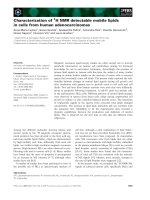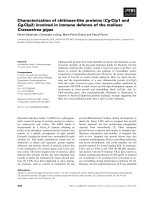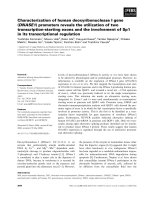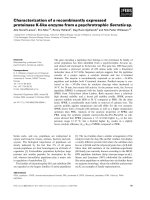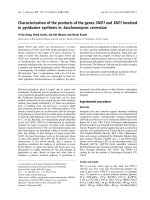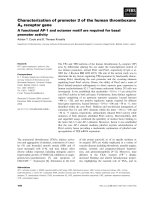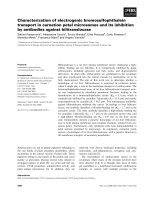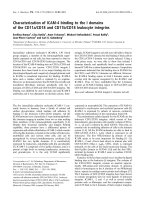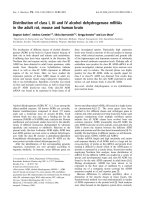Báo cáo khoa học: Characterization of rat cathepsin E and mutants with changed active-site residues and lacking propeptides and N-glycosylation, expressed in human embryonic kidney 293T cells ppt
Bạn đang xem bản rút gọn của tài liệu. Xem và tải ngay bản đầy đủ của tài liệu tại đây (611.55 KB, 11 trang )
Characterization of rat cathepsin E and mutants with
changed active-site residues and lacking propeptides and
N-glycosylation, expressed in human embryonic kidney
293T cells
Takayuki Tsukuba
1
, Shinobu Ikeda
2
, Kuniaki Okamoto
2
, Yoshiyuki Yasuda
1
, Eiko Sakai
2
,
Tomoko Kadowaki
1
, Hideaki Sakai
2
and Kenji Yamamoto
1
1 Department of Pharmacology, Graduate School of Dental Science, Kyushu University, Fukuoka, Japan
2 Department of Oral Molecular Pharmacology, Graduate School of Biomedical Sciences, Nagasaki University, Japan
Cathepsin E (EC 3.4.23.24) is an intracellular aspartic
proteinase of the A1 family, which consists of two
identical subunits of 42 kDa (reviewed in [1,2]). Evi-
dence suggests that it is initially synthesized as a pre-
proenzyme and is targeted to the correct destination
after proteolytic processing and carbohydrate modifi-
cation. Differing from the definite localization of the
analogous lysosomal aspartic proteinase, cathepsin D,
the intracellular localization of cathepsin E appears to
vary with cell type [3–5]. In antigen-presenting cells
such as macrophages and microglia, cathepsin E is
mainly found in the endosomal compartment as a
mature form which is N-glycosylated mostly with com-
plex-type oligosaccharides [6]. In erythrocytes [7–9],
gastric cells [10–13], renal proximal tubule cells [13],
and osteoclasts [14], cathepsin E is exclusively confined
Keywords
aspartic proteinase; cathepsin E; mutation;
processing; sorting
Correspondence
K. Yamamoto, Department of
Pharmacology, Graduate School of Dental
Science, Kyushu University, Higashi-ku,
Fukuoka 812-8582, Japan
Fax: +81 92 642 6342
Tel: +81 92 642 6337
E-mail:
(Received 10 October 2005, revised 7
November 2005, accepted 14 November
2005)
doi:10.1111/j.1742-4658.2005.05062.x
To study the roles of the catalytic activity, propeptide, and N-glycosylation
of the intracellular aspartic proteinase cathepsin E in biosynthesis, process-
ing, and intracellular trafficking, we constructed various rat cathepsin E
mutants in which active-site Asp residues were changed to Ala or which
lacked propeptides and N-glycosylation. Wild-type cathepsin E expressed
in human embryonic kidney 293T cells was mainly found in the LAMP-1-
positive endosomal organelles, as determined by immunofluorescence
microscopy. Consistently, pulse–chase analysis revealed that the initially
synthesized pro-cathepsin E was processed to the mature enzyme within
a 24 h chase. This process was completely inhibited by brefeldin A and
bafilomycin A, indicating its transport from the endoplasmic reticulum
(ER) to the endosomal acidic compartment. Mutants with Asp residues
in the two active-site consensus motifs changed to Ala and lacking the
propeptide (Leu23-Phe58) and the putative ER-retention sequence
(Ser59-Asp98) were neither processed nor transported to the endosomal
compartment. The mutant lacking the ER-retention sequence was rapidly
degraded in the ER, indicating the importance of this sequence in correct
folding. The single (N92Q or N324D) and double (N92Q ⁄ N324D) N-glyco-
sylation-deficient mutants were neither processed into a mature form nor
transported to the endosomal compartment, but were stably retained in the
ER without degradation. These data indicate that the catalytic activity,
propeptides, and N-glycosylation of this protein are all essential for its pro-
cessing, maturation, and trafficking.
Abbreviations
DMEM, Dulbecco’s modified Eagle’s medium; ER, endoplasmic reticulum; HEK, human embryonic kidney; LAMP, lysosome-associated
membrane protein.
FEBS Journal 273 (2006) 219–229 ª 2005 The Authors Journal compilation ª 2005 FEBS 219
to the plasma membrane. The enzyme from erythro-
cytes [15] is N-glycosylated mostly with complex-type
oligosaccharide chains, whereas that from gastric cells
[16] has high mannose-type oligosaccharides. Cathep-
sin E is also detected in the ER and Golgi complex in
various cell types, including gastric cells [12,13], human
M cells [5], Langerhans cells, and interdigitating reti-
culum cells [4]. However, fundamental information on
the biosynthesis, processing, and intracellular traffick-
ing of this protein as well as its physiological signifi-
cance remains elusive. Given the variability in cellular
localization, we decided that the roles of the catalytic
activity, propeptides, and N-glycosylation of cathep-
sin E in its processing, maturation, and trafficking
must be of particular importance.
In this study, to understand the molecular basis of
the processing and intracellular trafficking of cathep-
sin E, we constructed a variety of mutants as well as
wild-type enzyme. These included mutants with Asp
residues in the two active-site DTG motifs changed to
Ala residues and mutants lacking the propeptide, puta-
tive ER-retention sequence, and N-glycosylation of this
protein. These mutant proteins, as well as wild-type
cathepsin E, were expressed in human embryonic
kidney (HEK)-293T cells. We report that the catalytic
activity, propeptide, ER-retention sequence, and N-gly-
cosylation of this protein are all essential for process-
ing, maturation, and trafficking.
Results
Expression and cellular localization of recombinant
rat cathepsin E expressed in HEK-293T cells
In this study, we used HEK-293T cells to express wild-
type cathepsin E and its mutants and to follow the
processing, maturation, and trafficking of these pro-
teins, as these cells have no detectable endogenous
cathepsin E. To establish the expression system, we
transfected rat cathepsin E cDNA (wild-type) into
HEK-293T cells and analyzed the molecular forms of
the expressed proteins by SDS ⁄ PAGE under reducing
conditions followed by immunoblotting with polyclonal
antibodies to mature rat cathepsin E or rat pro-cathep-
sin E (Fig. 1). The transfected cells gave two intense
bands with apparent molecular masses of 46 and
42 kDa with antibodies to mature cathepsin E. Anti-
bodies to pro-cathepsin E, however, reacted with only
the 46-kDa form, indicating that the 46-kDa and
42-kDa bands are pro-cathepsin E and mature cathep-
sin E, respectively.
To follow the biosynthesis and processing of wild-
type cathepsin E, the transfected cells were labeled
with [
35
S]methionine for 30 min and chased in com-
plete Dulbecco’s modified Eagle’s medium (DMEM)
containing unlabeled methionine for different periods
of time up to 24 h. At the end of the chase, cells and
culture media were collected separately. The cell lysate
and culture medium were subjected to immunopreci-
pitation with antibodies to mature cathepsin E, and
the immunoprecipitates were then analyzed by SDS ⁄
PAGE followed by fluorography (Fig. 2A). After
30-min pulse labeling, cathepsin E was observed
mainly as a 46-kDa precursor with a small amount of
the 42-kDa mature form. A small amount of the pro-
enzyme was released into the culture medium as a
48-kDa form and accumulated during the chase
period. The difference in the molecular mass between
the extracellular and intracellular proforms is probably
due to the difference in their carbohydrate modifica-
tions, because the former has endoglycosidase H-
sensitive high-mannose-type oligosaccharide chains,
whereas the latter possesses endoglycosidase H-resist-
ant complex-type oligosaccharide chains (Fig. 6A). The
42-kDa mature form in the cells was time-dependently
increased, and the 46-kDa pro-cathepsin E was almost
completely converted into the 42-kDa mature cathep-
sin E after a 24-h chase. These processing events were
strongly inhibited by the fungal metabolite brefeldin A
AB
Fig. 1. Immunoblot analysis of the cell extract of HEK-293T cells
expressing wild-type cathepsin E. HEK-293T cells were transfected
with rat cathepsin E cDNA. The cell lysate was subjected to
SDS ⁄ PAGE under reducing conditions followed by immunoblotting
with antibody to either mature cathepsin E (A) or pro-cathepsin E (B).
Recombinant cathepsin E and its mutants T. Tsukuba et al.
220 FEBS Journal 273 (2006) 219–229 ª 2005 The Authors Journal compilation ª 2005 FEBS
(Fig. 2B), which is known to inhibit export of newly
synthesized proteins from the ER to the Golgi complex
[17] and also to cause reversible redistribution of Golgi
resident proteins into the ER [18]. The strong inhibi-
tion of the processing of pro-cathepsin E into the
mature enzyme by brefeldin A indicates that the pro-
cessing and maturation of this protein occur in the
post-Golgi compartment. In addition, this agent pre-
vented the secretion of subspecies of the precursor,
probably mediated by an alternative secretory pathway
at the exit from the ER.
Available evidence indicates that internal acidifica-
tion of some compartments in the vacuolar system,
such as endosomes and lysosomes, is important in bio-
synthesis, sorting, transport, and degradation of pro-
teins and other macromolecules [19–21]. When the
transfected cells were treated with bafilomycin A1, a
specific inhibitor of vacuolar-type H
+
-ATPase, the
processing and maturation of pro-cathepsin E was
completely inhibited, with a concomitant increase in
a secreted form of pro-cathepsin E in the culture
medium (Fig. 2C). Given that bafilomycin A1 effect-
ively inhibits acidification of intracellular acidic organ-
elles including endosomes, lysosomes, and phagosomes
without perturbation of the formation of intracellular
organelles and without alteration of the morphology
of vacuolar compartments, resulting in the profound
inhibition of the endosomal ⁄ lysosomal degradation of
macromolecules and targeting of lysosomal acid hydro-
lases and cholesterol to the lysosome and processing of
various secretory proteins including prohormones in
the trans-Golgi network [22], our results indicate that
acidification of intracellular acidic compartments is
necessary for the processing and maturation of pro-
cathepsin E.
To determine the intracellular localization of wild-
type cathepsin E expressed in HEK-293T cells, indirect
immunofluorescence staining was performed (Fig. 3A).
With antibodies to mature cathepsin E, the transfected
cells showed mainly punctate staining and partly
reticular staining over the whole cytoplasm, consistent
with staining of the lysosome-associated membrane
protein LAMP-1 and the ER-associated molecular
chaperon Bip, respectively. In agreement with the data
of the pulse–chase analysis, the results indicate that the
proteolytic maturation of pro-cathepsin E occurs in
the endosomal acidic compartment.
Importance of the catalytic activity of cathepsin E
in acid-dependent autoactivation
In vitro studies have shown that pro-cathepsin E is
rapidly converted into mature cathepsin E by a brief
acid treatment [9,23]. However, whether the catalytic
activity of cathepsin E is essential for its processing
and maturation in vivo has not been elucidated. To
throw light on this, we constructed an active-site
mutant by changing Asp residues in the two active-site
motifs (DTG) to Ala residues using site-directed muta-
genesis (D98A ⁄ D283A). This mutant protein was
expressed in HEK-293T cells. We confirmed that the
D98A ⁄ D283A mutant had no catalytic activity on
either protein or synthetic substrates, as described in
our previous study, in which the single mutants D98A
and D283A, as well as the double mutant, exhibited
no catalytic activity in vitro [24]. The autoprocess-
ing capability of this mutant protein was analyzed
by pulse–chase experiments with [
35
S]methionine
(Fig. 4). In contrast with wild-type cathepsin E, the
D98A ⁄ D283A mutant in the cells was neither proc-
essed nor matured even after a 24-h chase period, but
stably remained as a 46-kDa precursor, indicating that
the catalytic activity is essential for the processing and
maturation of this protein.
A
B
C
Fig. 2. Pulse–chase analysis of wild-type cathepsin E expressed in
HEK-293T cells. (A) The transfected cells were metabolically labeled
with [
35
S]methionine ⁄ cysteine for 30 min and chased for the times
indicated. Cathepsin E in the cell lysate and culture medium was
immunoprecipitated with antibodies to mature rat cathepsin E, and
analyzed by SDS ⁄ PAGE under reducing conditions and fluorogra-
phy. (B, C) The transfected cells were preincubated at 37 °C for
3 h in the presence of 5 lgÆmL
)1
brefeldin A (B) or 0.5 lM bafilomy-
cin A1 (C). The cells were labeled with [
35
S]methionine ⁄ cysteine
for 30 min and chased for the times indicated in the continued
presence of the drugs. The cell lysate and the culture medium
were immunoprecipitated with antibodies to mature rat cathep-
sin E. The immunoprecipitates were analyzed by SDS ⁄ PAGE under
reducing conditions followed by fluorography.
T. Tsukuba et al. Recombinant cathepsin E and its mutants
FEBS Journal 273 (2006) 219–229 ª 2005 The Authors Journal compilation ª 2005 FEBS 221
Role of the propeptides of cathepsin E in
processing and maturation
Recent studies have suggested that the propeptides of
aspartic proteinases are necessary for correct folding
and cellular sorting [25–27] and that activation of their
zymogens is initiated by a dramatic conformational
rearrangement of the zymogen propeptides [28,29].
This process is often triggered by acidic pH, resulting
in the proteolytic removal of propeptides [29]. More
recently, using chimeric DNAs encoding the cathep-
sin E propeptide fused to mature cathepsin D tagged
Fig. 3. Immunofluorescence microscopy of wild-type cathepsin E and its mutants in the transfected HEK-293T cells. (A) At 48 h after post-
transfection with wild-type cathepsin E cDNA in HEK-293T cells, the cells were fixed and allowed to react with antibodies to mature rat
cathepsin E, Bip, or LAMP-1. After being washed, the cells were incubated for 1 h with fluorescein isothiocyanate-conjugated or tetra-
methylrhodamine isothiocyanate-conjugated secondary antibodies, and then visualized by confocal laser microscopy. Wild-type cathepsin E is
found mainly in the LAMP-1-positive endosomal organelles and partly in the Bip-positive ER. (B, C) The subcellular localization of the deletion
mutants lacking the propeptide (Dpro) (B) and the ER-retention motif (DER ret.) expressed in HEK-293T cells was analyzed under the same
conditions as described in (A). Both mutants were exclusively confined to the ER, but not to the LAMP-1-positive organelles.
Recombinant cathepsin E and its mutants T. Tsukuba et al.
222 FEBS Journal 273 (2006) 219–229 ª 2005 The Authors Journal compilation ª 2005 FEBS
with haemagglutinin at the C-terminus and encoding
the cathepsin D propeptide fused to mature cathep-
sin E, we have demonstrated that the propeptide of
cathepsin E, likewise those of other aspartic protei-
nases, plays an important role in the correct folding,
maturation, and targeting of this protein to its final
destination [30]. To establish further the role of the
propeptide in the processing and maturation of cathep-
sin E, we constructed a mutant lacking the propeptide
(Leu23-Phe58) and expressed it in HEK-293T cells.
The transfected cells were pulse-labeled with
[
35
S]methionine for 30 min and chased for different
periods up to 24 h (Fig. 5B). In the cells, this mutant
protein was first synthesized as a 42-kDa precursor but
was neither processed nor matured even after a 24-h
chase period. Little protein was released into the med-
ium. Consistent with these data, immunofluorescence
microscopy revealed that this mutant protein was
found mostly in the Bip-positive ER compartment, but
not LAMP-1-positive organelles (Fig. 3B).
Finley & Kornfeld [31] expressed various chimeric
proteins between cathepsin E and pepsinogen in
monkey Cos 1 cells and analyzed their targeting and
subcellular localization. They showed that the amino-
acid sequence 1–48 of human mature cathepsin E,
which corresponds to 55–103 of the signal sequence
[32], appeared to be essential for the retention of cath-
epsin E in the ER. We thus examined whether this
putative ER-retention sequence is also required for the
processing, maturation, and trafficking of cathepsin E
to the appropriate destination using a mutant lacking
most of the ER-retention sequence (Ser59-Asp98).
Pulse–chase analysis revealed that this mutant protein
was initially synthesized as a 41-kDa precursor but not
processed into a mature form. Importantly, this
mutant protein was rapidly degraded in the cells dur-
ing a chase period up to 2 h without any detectable
formation of its mature form (Fig. 5C). In addition,
we found that the level of expression of this mutant
A
B
C
Fig. 4. Pulse–chase analysis of the active-site mutant with Asp resi-
dues in the two active-site motifs changed to Ala residues. (A)
Schematic representation of the structures of wild-type cathepsin E
and its active-site mutant. Asp residues in the two active-site con-
sensus motifs (98DTG100 and 273DTG275) are substituted by Ala
residues in the mutant. (B, C) HEK-293T cells expressing wild-type
cathepsin E (B) and the active-site mutant (C) were pulse-labeled
with [
35
S]methionine ⁄ cysteine for 30 min and chased for the times
indicated. The cell lysate and the culture medium were immuno-
precipitated with antibodies to mature rat cathepsin E. The
immunoprecipitates were analyzed by SDS ⁄ PAGE under reducing
conditions followed by fluorography.
C
B
A
Fig. 5. Pulse–chase analysis of the mutants lacking the propeptide
and ER-retention sequence. (A) Schematic representation of the
structures of the mutants lacking the propeptide and most of the
ER-retention sequence. (B, C) The transfected cells expressing
the mutants lacking the propeptide (Dpro) (B) and the ER-retention
sequence (DER-ret.) (C) were pulse-labeled with [
35
S]methio-
nine ⁄ cysteine for 30 min and chased for the times indicated. The
cell lysate and the culture medium were immunoprecipitated with
antibodies to mature rat cathepsin E. The immunoprecipitates were
analyzed by SDS ⁄ PAGE under reducing conditions followed by fluo-
rography. The arrows indicate degradation products of the DER-ret.
mutant.
T. Tsukuba et al. Recombinant cathepsin E and its mutants
FEBS Journal 273 (2006) 219–229 ª 2005 The Authors Journal compilation ª 2005 FEBS 223
was low compared with wild-type-cathepsin E and
other mutant proteins. It was found in the Bip-positive
ER compartment, but not in LAMP-1-positive organ-
elles (Fig. 3C). These results strongly suggest that the
putative ER-retention sequence is absolutely required
for the correct folding, processing maturation, and tar-
geting of cathepsin E to the endosomal compartment.
Characterization of N-linked oligosaccharide
chains of cathepsin E
We have previously demonstrated that cathepsin E
from human erythrocyte membranes [9,15] and rat
microglia [6] is N-glycosylated with complex-type
oligosaccharides, whereas the enzyme from rat spleen
[9,33] and rat stomach [16] has high-mannose-type
oligosaccharide chains. These results suggest that the
nature of the N-glycosylation of cathepsin E varies
with cell type or its cellular localization. We thus ana-
lyzed the nature of the oligosaccharide chains of rat
cathepsin E in the transfected cells and then assessed
the role of N-glycosylation in its folding, processing,
maturation, and subcellular trafficking. HEK-293T
cells expressing wild-type cathepsin E were pulse-labe-
led with [
35
S]methionine for 30 min and chased with
unlabeled methionine for 24 h. The intracellular and
extracellular cathepsin E were immuoprecipitated with
antibodies to mature rat cathepsin E, and the immuno-
precipitates were treated with endoglycosidase H and
then analyzed by SDS ⁄ PAGE followed by fluorogra-
phy (Fig. 6A). Both newly synthesized pro-cathepsin E
(30-min pulse) and the fully matured enzyme (24-h
chase) in the cells were sensitive to endoglycosidase H.
A decrease in the molecular mass of 2–2.5 kDa resul-
ted, indicating the presence of at least a single high-
mannose-type oligosaccharide chain. In contrast, the
extracellular cathepsin E molecules at 30-min pulse
labeling and after 24-h chase were resistant to endo-
glycosidase H, indicating that they were secreted after
modification with complex-type oligosaccharides.
Cathepsin D, like other lysosomal enzymes, is phos-
phorylated in a portion of the oligosaccharide chains
during passage through the Golgi complex [34,35]. This
process is considered to be important for the recognition
of cathepsin D by mannose 6-phosphate receptors and
its delivery to the prelysosomal compartment. To deter-
mine whether the oligosaccharides of cathepsin E are
phosphorylated, the transfected cells were labeled with
[
32
P]phosphate for 12 h, and then wild-type cathepsin E
as well as endogenous cathepsin D was immunoprecipi-
tated by antibodies specific for each enzyme (Fig. 6B).
Whereas the oligosaccharide chains of cathepsin D
were, at least in part, clearly phosphorylated, and this
phosphorylation had disappeared after endoglycosidase
H treatment, wild-type cathepsin E was not phosphoryl-
ated at all, suggesting that this may serve to sort cathep-
sin E from lysosomal enzymes.
Role of the N-glycosylation of cathepsin E
in processing and maturation
To determine the role of N-glycosylation in the correct
folding, processing, maturation, and subcellular traf-
ficking of cathepsin E, we constructed mutants lack-
ing one or two N-glycosylation sites by site-directed
mutagenesis. We have previously shown that the
A
B
Fig. 6. Characterization of oligosaccharide chains of wild-type cath-
epsin E and endogenous cathepsin D. (A) HEK-293 cells expressing
wild-type cathepsin E were pulse-labeled with [
35
S]methionine ⁄
cysteine for 30 min and chased for 24 h. The cell lysate and
the culture medium were immunoprecipitated with antibodies to
mature rat cathepsin E. The immunoprecipitates were then incuba-
ted at 37 °C for 18 h with or without endoglycosidase H. The
mixtures were analyzed by SDS ⁄ PAGE under reducing condi-
tions followed by fluorography. (B) The transfected cells were
pulse-labeled with [
32
P]orthophosphate for 12 h. The cell lysate and
the culture medium were immunoprecipitated with antibodies to
either mature rat cathepsin E or rat cathepsin D. The immuno-
precipitates were incubated at 37 °C for 18 h with or without
endoglycosidase H. The mixtures were analyzed by SDS ⁄ PAGE
under reducing conditions followed by fluorography.
Recombinant cathepsin E and its mutants T. Tsukuba et al.
224 FEBS Journal 273 (2006) 219–229 ª 2005 The Authors Journal compilation ª 2005 FEBS
N-glycosylation null mutant of cathepsin E
(N92Q ⁄ N374D) was less stable to temperature and pH
than glycosylated cathepsin E, although the catalytic
properties of the mutant were equivalent to those of
the wild-type enzyme [15]. In this study, we performed
pulse–chase experiments with HEK-293 cells expressing
N-glycosylation mutants. The results show that two
single N-glycosylation mutants (N92Q and N324D),
as well as the double N-glycosylation mutant
(N92Q ⁄ N374D), were stably retained in the cells, but
not processed to the mature form even after a 24-h
chase period (Fig. 7). Immunofluorescence microscopy
indicated that all of the N-glycosylation mutants were
exclusively confined to the Bip-positive ER compart-
ment (data not shown). Therefore, our data indicate
that N-glycosylation of cathepsin E plays an important
role in its processing, maturation, and trafficking to
the appropriate destination in the cells, but is not
necessarily essential for its correct folding.
Discussion
To assess the roles of the catalytic activity, propep-
tides, and N-glycosylation of cathepsin E in its
processing, maturation, and targeting to its final des-
tination, we constructed wild-type rat cathepsin E and
a variety of its mutants, and successfully expressed
them in heterologous HEK-293T cells. The results
provide the first experimental evidence that the cata-
lytic activity, propeptide, ER-retention motif, and
N-glycosylation are all essential for its processing,
maturation, and intracellular trafficking to the endo-
somal compartment. This conclusion is based on sev-
eral lines of evidence. First, the pulse–chase analysis
showed that the wild-type enzyme in the transfected
cells was processed from pro-cathepsin E to the
mature form within a 24-h chase period. Consistent
with this finding, immunofluorescence microscopy
revealed that wild-type cathepsin E was found mostly
in LAPM-1-positive organelles and significantly in the
ER. Given that cathepsin E in rat microglia is mainly
localized in endosome-like vacuoles distinct from typ-
ical lysosomes, as determined by immunoelectron
microscopy [6] and that the localization of this
enzyme in mouse microglia is consistent with that of
LAMP-2-positive organelles [36], wild-type cathep-
sin E in the transfected cells is probably targeted to
the endosomal compartment. However, the processing
of wild-type cathepsin E in the transfected cells
appears to be slower than that of natural cathepsin E
in rat microglia [6]. This is probably due to the dif-
ference in the level of expression of cathepsin E
between the transfected cells and the primary cultured
microglia. In contrast, none of the mutants were
processed or targeted to the endosomal compartment.
Interestingly, the intracellular localization of recom-
binant cathepsin E appears to vary with the cell type
used. In mouse L cell and monkey Cos 1 cells, the
expressed human cathepsin E is localized in the ER as
a precursor form [31]. Similarly, rat cathepsin E
expressed in normal rat kidney cells and monkey Cos 1
cells is exclusively confined to the ER (T. Tsukuba, T.
Kadowaki and K. Yamamoto, unpublished work)
1
.
Meanwhile, human cathepsin E expressed in Chinese
hamster ovary cells is found in various subcellular com-
partments such as the vacuolar endolysosomal system,
the ER, and the cytosol [37]. The present results thus
indicate that HEK-293T cells are useful for studying
the biosynthesis, processing, maturation, and trafficking
to the correct destination of cathepsin E.
Secondly, the mutant lacking the catalytic activity of
cathepsin E in the transfected cells failed to be conver-
ted to the mature form, indicating that the catalytic
A
B
C
D
Fig. 7. Pulse–chase analysis of the mutants lacking N-glycosylation.
(A) Schematic representation of the structures of the mutants lack-
ing single (N92Q or N324D) and double N-glycosylation sites
(N92Q ⁄ N324D). Asn residues in the two potential N-glycosylation
sites (92NFT94 and 324NVT326) are substituted by Gln and ⁄ or Asp
residues in the mutants. (B–D) HEK-293 cells expressing each
mutant as well as wild-type cathepsin E were pulse-labeled with
[
35
S]methionine ⁄ cysteine for 30 min and chased with nonradiolabe-
led medium for the times indicated. The cell lysate and culture
medium were immunoprecipitated with antibodies to mature rat
cathepsin E. The immunoprecipitates were analyzed by SDS ⁄ PAGE
under reducing conditions followed by fluorography. (B) N92Q; (C)
N324D; (D) N92Q ⁄ N324D.
T. Tsukuba et al. Recombinant cathepsin E and its mutants
FEBS Journal 273 (2006) 219–229 ª 2005 The Authors Journal compilation ª 2005 FEBS 225
activity is necessary for processing and maturation.
Although pro-cathepsin D is capable of acid-dependent
autoactivation to yield catalytically active pseudo-cath-
epsin D [38–40], lysosomal cysteine proteinase(s) is
required to accomplish proteolytic removal of the entire
propeptide [29,41]. BACE ⁄ memapsin, a membrane-type
aspartic proteinase, is also processed by furin-like con-
vertase(s) [42–44]. In contrast, secretory-type aspartic
proteinases, such as pepsin A, chymosin and gastricsin,
are capable of acid-dependent autoactivation to yield
their mature forms without the aid of other proteinases
[45,46]. Therefore, it is of interest that cathepsin E
undergoes acid-dependent autoproteolysis to yield
mature cathepsin E in a similar manner to secretory
aspartic proteinases rather than nonsecretory enzymes.
Thirdly, whereas the cathepsin D mutant lacking its
propeptide expressed in mouse Ltk
–
cells was rapidly
degraded, probably in the ER [47], the propeptide-
deletion cathepsin E mutant in HEK-293T cells was
relatively stable in the ER but was neither processed
nor targeted to the endosomal compartment, indicating
the importance of the propeptide in the processing,
maturation, and trafficking of this protein. However,
the cathepsin E mutant lacking the putative ER-retent-
ion sequence was rapidly degraded in the ER, suggest-
ing that the ER-retention sequence is necessary for
correct folding. In addition, this mutant did not
undergo processing, maturation, and trafficking to the
endosomal compartment.
Finally, we have shown that intracellular wild-type
cathepsin E was N-glycosylated with high-mannose-
type oligosaccharides, as demonstrated by endoglycosi-
dase H sensitivity, whereas the extracellular enzyme
had endoglycosidase H-resistant oligosaccharides. Pre-
vious studies have shown that modification of oligosac-
charide chains of cathepsin E differs between cell
types. Therefore, it is difficult to explain the process-
ing, maturation, and targeting of cathepsin E by the
nature of its oligosaccharide chains. We thus construc-
ted three N-glycosylation mutants and expressed them
in HEK-293T cells to determine the importance of
N-glycosylation in the processing, maturation, and
trafficking of this protein. Pulse–chase analysis and
immunofluorescence microscopy revealed that neither
single (N92Q, N324D) nor double (N92Q ⁄ N374D)
N-glycosylation mutants were processed into the
mature forms, but were stably retained in the ER with-
out degradation after a 24-h chase period. As all of
the N-glycosylation mutants were converted into the
active enzyme on acidification (data not shown), each
the oligosaccharide chain appears to be not necessarily
required for correct folding but to be essential for
processing, maturation, and trafficking.
Moreover, we show for the first time that wild-type
cathepsin E is not phosphorylated on either the poly-
peptide backbone or the oligosaccharide chains. Pre-
vious studies have shown that mannose 6-phosphate
receptors participate in general in the sorting of indi-
vidual lysosomal proteins, albeit with variable effi-
ciency [35,48]. The enzyme phosphotransferase, which
transfers phosphate to the high-mannose oligosaccha-
ride chain of individual lysosomal proteins, recognizes
conformational determinants on the proenzymes [49].
The phosphorylation of cathepsin D occurs mainly at
the large oligosaccharide chain of two glycosylation
sites [50]. In agreement with previous studies, this
work indicates that cathepsin D is apparently phos-
phorylated on its oligosaccharide chains. Therefore, we
conclude that the sorting and segregation of cathep-
sin E from other secretory proteins is independent of
mannose 6-phosphate mechanisms.
Experimental procedures
Materials
[
35
S]Methionine ⁄ cysteine and Protein A–Sepharose were
purchased from Amersham Biosciences (Piscataway, NJ,
USA). Pansorbin was from Calbiochem (La Jolla, CA,
USA). The pcDNA 3.0 ⁄ Amp plasmid, DMEM, methio-
nine-free DMEM, and Opti-Mem were from Invitrogen
(Carlsbad, CA, USA). Endoglycosidase H was from Boeh-
ringer Mannheim (Mannheim, Germany). Centriprep-30
and Microcon-30 concentrators were from Millipore (Bed-
ford, MA, USA). Fluorescein isothiocyanate-conjugated
and tetramethylrhodamine isothiocyanate-conjugated secon-
dary antibodies were from BD Bioscience (San Jose, CA,
USA). Vectashield was from Vector Laboratory Inc. (Bur-
lingame, CA, USA). Antibodies to Bip (GRP 78) and
Lamp1 were from Stressgen Bioreagents (Victoria, BC,
Canada). Antibodies to rat cathepsin E and to rat cathep-
sin D were raised in rabbit and purified as described previ-
ously [24]. Polyclonal antibodies to the synthetic peptide
Ser-Gln-Leu-Ser-Glu-Phe-Trp-Lys-Ser-His-Asn-Leu-Asp-Met,
which corresponds to the prosequence comprising residues
Ser23-Met36 of human procathepsin E, were raised in rab-
bits and purified on the peptide–Sepharose affinity column
as described previously [24).
Plasmid construction and mutagenesis
The pBluescript II SK plasmid containing full-length wild-
type rat cathepsin E cDNA was described previously
[15,24]. Deletion mutants lacking the ER retention sequence
(DER ret.) and the propeptide (Dpro) were constructed by
the method of Kunkel [51] with some modifications. The
oligonucleotide primers used in the mutagenesuis reaction
Recombinant cathepsin E and its mutants T. Tsukuba et al.
226 FEBS Journal 273 (2006) 219–229 ª 2005 The Authors Journal compilation ª 2005 FEBS
were as follows: primer 1, 5¢-ATGATCGAATTCACGGG
CGGCTCA-3¢ (for DER ret.); primer 2, 5¢-CAGGC
CCAAGGGGTGAGCGAGTCCTGT-3¢ (for Dpro). All
constructs were verified as correct by DNA sequence analy-
ses. The cDNAs of wild-type cathepsin E and its mutants
were transfected into pcDNA 3.0 plasmid for heterologous
expression in mammalian cells.
Tissue culture and transfection
HEK-293T cells were maintained in DMEM supplemented
with 10% fetal calf serum, 50 UÆmL
)1
penicillin and
50 lgÆmL
)1
streptomycin (complete DMEM) in a 37 °C
incubator with 5% CO
2
. Wild-type cathepsin E and its
mutants were expressed in HEK-293T cells after transfec-
tion by the calcium phosphate precipitation method using
10 lg expression plasmid in a 100-mm tissue culture plate
[24]. Cells were grown to 90% confluency by overnight
incubation in complete DMEM.
Preparation of cell lysate and culture medium
The tissue culture media were collected after 48 h of transfec-
tion and subjected to centrifugation at 16 000 g for 20 min.
The supernatants were concentrated 10-fold to 500 lL ⁄ plate
using Centriprep-30 and Microcon-30 concentrators. The
cells were washed twice with NaCl ⁄ P
i
, removed from the
plates with a rubber scraper, and subjected to centrifugation
at 300 g for 5 min. The sedimented cells were suspended in
NaCl ⁄ P
i
containing 0.1% Triton X-100, sonicated for 1 min
at 4 °C, and subjected to centrifugation at 100 000 g for 1 h;
the supernatant fraction is referred to as the cell lysate.
Pulse–chase analysis
The transfected cells were preincubated for 1 h at 37 °Cin
DMEM without methionine supplemented with 10% dia-
lyzed fetal bovine serum. The cells were pulse-labeled for
30 min with [
35
S]methionine ⁄ cysteine (100 lCiÆmL
)1
per
dish), and then chased in fresh serum-free Opti-MEM
(1.5 mL ⁄ plate). At the times indicated, the cells were separ-
ated from the medium, washed twice with NaCl ⁄ P
i
, lysed in
NaCl ⁄ P
i
containing 1% Triton X-100, 0.5% sodium de-
oxycholate, 0.02% sodium azide, and a proteinase inhibitor
cocktail, and subsequently sonicated for 1 min. The suspen-
sion was centrifuged at 6500 g for 10 min to obtain the cell
lysate fraction.
Immunoprecipitation
The cells and media were mixed with 40 lL Pansorbin for
1 h at 4 °C to prevent nonspecific binding to IgG–Protein
A beads, and then centrifuged at 6500 g for 30 min. The
supernatants fractions were incubated with 15 l L anti-(rat
cathepsin E) IgG at 37 °C for 10 min, and then stored at
4 °C for 16 h. The immunoprecipitates were mixed with
40 lL Protein A–Sepharose beads (50% gel suspension) for
3 h at 4 °C with gentle agitation. The beads were washed
3 times with 0.1% SDS ⁄ 0.1% Triton X-100 ⁄ 200 mm
EDTA ⁄ 10 mm Tris ⁄ HCl (pH 7.5), washed another 3 times
with the same buffer containing 1 m NaCl and 0.1%
sodium lauryl sarcosinate, then washed twice with 5 mm
Tris ⁄ HCl (pH 7.0). The beads were boiled for 5 min at
100 °C with 50 mL 0.1% SDS ⁄ 0.5 mm EDTA ⁄ 5% sucrose ⁄
5mm Tris ⁄ HCl (pH 8.0) with 2-mercaptoethanol.
SDS ⁄ PAGE and immunoblotting
SDS ⁄ PAGE and immunoblotting were performed as des-
cribed previously [24].
Endoglycosidase digestion
Radiolabeled immunoprecipitates were dissolved by being
boiled for 5 min at 100 °Cin10lL5mm Tris ⁄ HCl
(pH 8.0) containing 0.2% SDS. To this was added 90 lL
50 mm sodium acetate buffer (pH 6.0) containing 0.75%
Triton X-100 and 100 lgÆmL
)1
protease inhibitor cocktail
and 10 mU endoglycosidase H, and then incubated at
37 °C for 18 h. Reactions were stopped by boiling the sam-
ples in SDS ⁄ PAGE sample buffer.
Immunofluorescence microscopy
The transfected cells were grown on glass coverslips. The
cells were briefly washed with NaCl ⁄ P
i
and fixed with 3.7%
formaldehyde in NaCl ⁄ P
i
for 10 min at room temperature.
The fixed cells were washed and permeabilized with 0.2%
Triton X-100 in NaCl ⁄ P
i
. The cells were incubated with the
indicated primary antibodies for 1 h at room temperature.
Antibodies to mature rat cathepsin E, rat pro-cathepsin E,
rat Bip, and rat LAMP-1 were used as primary antibodies.
After being washed, the cells were incubated for 1 h with
fluorescein isothiocyanate-conjugated or tetramethylrhod-
amine isothiocyanate-conjugated secondary antibodies.
After treatment with Vectashield, the cells were observed
by confocal microscopy (Leica Microsystems).
References
1 Yamamoto K (1995) Cathepsin E and cathepsin D: bio-
synthesis, processing and subcellular location. In Aspar-
tic Proteinases: Structure, Function, Biology, and
Biomedical Implications (Takahashi K, ed.), pp. 223–
229. Plenum Press, New York.
2 Yamamoto K (1999) Cathepsin E and cathepsin D. In
Protease: New Perspectives (Turk V, ed.), pp. 59–71.
Birkhauser, Switzerland.
T. Tsukuba et al. Recombinant cathepsin E and its mutants
FEBS Journal 273 (2006) 219–229 ª 2005 The Authors Journal compilation ª 2005 FEBS 227
3 Sakai H, Saku T, Kato Y & Yamamoto K (1989)
Quantitation and immunohistochemical localization of
cathepsins E and D in rat tissues and blood cells. Bio-
chim Biophys Acta 991, 367–375.
4 Solcia E, Paulli M, Silini E, Fiocca R, Finzi G, Kindl S,
Boveri E, Bosi F, Cornaggia M, Capella C, et al. (1993)
Cathepsin E in antigen-presenting Langerhans and
interdigitating reticulum cells. Its possible role in anti-
gen processing. Eur J Histochem 37, 19–26.
5 Finzi G, Cornaggia M, Capella C, Fiocca R, Bosi F,
Solcia E & Samloff IM (1993) Cathepsin E in follicle
associated epithelium of intestine and tonsils: localiza-
tion to M cells and possible role in antigen processing.
Histochemistry 99, 201–211.
6 Sastradipura DF, Nakanishi H, Tsukuba T, Nishishita
K, Sakai H, Kato Y, Gotow T, Uchiyama Y & Yama-
moto K (1998) Identification of cellular compartments
involved in processing of cathepsin E in primary cul-
tures of rat microglia. J Neurochem 70, 2045–2056.
7 Yamamoto K & Marchesi VT (1984) Purification and
characterization of acid proteinase from human erythro-
cyte membranes. Biochim Biophys Acta 790, 208–218.
8 Takeda M, Ueno E, Kato Y & Yamamoto K (1986)
Isolation, and catalytic and immunochemical properties
of cathepsin D-like acid proteinase from rat erythro-
cytes. J Biochem (Tokyo) 100, 1269–1277.
9 Takeda-Ezaki M & Yamamoto K (1993) Isolation and
biochemical characterization of procathepsin E from
human erythrocyte membranes. Arch Biochem Biophys
304, 352–358.
10 Kageyama T & Takahashi K (1980) A cathepsin D-like
acid proteinase from human gastric mucosa. Purification
and characterization. J Biochem (Tokyo) 87, 725–735.
11 Muto N, Murayama-Arai K & Tani S (1983) Purifica-
tion and properties of a cathepsin D-like acid proteinase
from rat gastric mucosa. Biochim Biophys Acta 745,
61–69.
12 Samloff IM, Taggart RT, Shiraishi T, Branch T, Reid
WA, Heath R, Lewis RW, Valler MJ & Kay J (1987)
Slow moving proteinase. Isolation, characterization, and
immunohistochemical localization in gastric mucosa.
Gastroenterology 93, 77–84.
13 Saku T, Sakai H, Shibata Y, Kato Y & Yamamoto K
(1991) An immunocytochemical study on distinct intra-
cellular localization of cathepsin E and cathepsin D in
human gastric cells and various rat cells. J Biochem
(Tokyo) 110, 956–964.
14 Yoshimine Y, Tsukuba T, Isobe R, Sumi M, Akamine
A, Maeda K & Yamamoto K (1995) Specific immuno-
cytochemical localization of cathepsin E at the ruffled
border membrane of active osteoclasts. Cell Tissue Res
281, 85–91.
15 Yasuda Y, Ikeda S, Sakai H, Tsukuba T, Okamoto K,
Nishishita K, Akamine A, Kato Y & Yamamoto K
(1999) Role of N-glycosylation in cathepsin E: a
comparative study of cathepsin E with distinct N-linked
oligosaccharides and its nonglycosylated mutant. Eur J
Biochem 266, 383–391.
16 Yonezawa S, Takahashi T, Ichinose M, Miki K, Tan-
aka J & Gasa S (1990) Structural studies of rat cathe-
psin E: amino-terminal structure and carbohydrate units
of mature enzyme. Biochem Biophys Res Commun 166,
1032–1038.
17 Fujiwara T, Oda K, Yokota S, Takatsuki A & Ikehara
Y (1988) Brefeldin A causes disassembly of the Golgi
complex and accumulation of secretory proteins in the
endoplasmic reticulum. J Biol Chem 263, 18545–18552.
18 Doms RW, Russ G & Yewdell JW (1989) Brefeldin A
redistributes resident and itinerant Golgi proteins to the
endoplasmic reticulum. J Cell Biol 109, 61–72.
19 Mellman I, Fuchs R & Helenius A (1986) Acidification
of the endocytic and exocytic pathways. Annu Rev
Biochem 55, 663–700.
20 Tycko B & Axfield FR (1982) Rapid acidification of
endocytic vesicles containing a2-macroglobulin. Cell 28,
643–651.
21 Merion M, Schlesinger P, Brooks M, Moehring JM,
Moehring TJ & Sly WS (1983) Defective acidification of
endosomes in Chinese hamster ovary cell mutants ‘cross
resistant’ to toxins and viruses. Proc Natl Acad Sci USA
80, 5315–5319.
22 Xu H & Shields D (1994) Prosomatostatin processing in
permeabilized cells. Endoproteolytic cleavage is
mediated by a vacuolar ATPase that generate an acidic
pH in the trans-Golgi network. J Biol Chem 269,
22875–22881.
23 Athauda SBP, Takahashi T, Kageyama T & Takahashi
K (1991) Autocatalytic processing of procathepsin E to
cathepsin E and their structural differences. Biochem
Biophys Res Commun 175, 152–158.
24 Liu J, Tsukuba T, Okamoto K, Ohishi M & Yamamoto
K (2002) Mutational analysis of residues in two consen-
sus motifs in the active sites of cathepsin E. J Biochem
(Tokyo) 132, 493–499.
25 Yonezawa S, Takahashi T, Wang X, Wong RNS, Hart-
suck JA & Tang J (1988) Structures at the proteolytic
processing region of cathepsin D. J Biol Chem 263,
16504–16511.
26 Klionsky DJ, Banta LM & Emr SD (1988) Intracellular
sorting and processing of a yeast vacuolar hydrolase:
proteinase A propeptide contains vacuolar targeting
information. Mol Cell Biol 8, 2105–2116.
27 Rijinboutt S, Aerts H, Geuze HJ, Tager JM & Strous
GJ (1991) Mannose 6-phosphate–independent mem-
brane association of cathepsin D, glucocerebrosidase,
and sphingolipid-activating protein in HepG2 cells.
J Biol Chem 266, 4862–4868.
28 James MNG & Sielecki AR (1986) Molecular structure
of an aspartic proteinase zymogen, porcine pepsinogen,
at 1.8 A
˚
resolution. Nature 319, 33–38.
Recombinant cathepsin E and its mutants T. Tsukuba et al.
228 FEBS Journal 273 (2006) 219–229 ª 2005 The Authors Journal compilation ª 2005 FEBS
29 Foltmann B (1988) Structure and function of proparts
in zymogens for aspartic proteinases. Biol Chem Hoppe-
Seyler 369, 311–314.
30 Yasuda Y, Tsukuba T, Okamoto K, Kadowaki T &
Yamamoto K (2005) The role of the cathepsin E pro-
peptide in correct folding, maturation and sorting to the
endosome. J Biochem (Tokyo) 138, 621–630.
31 Finley EM & Kornfeld S (1994) Subcellular localization
and targeting of cathepsin E. J Biol Chem 269, 31259–
31266.
32 Azuma T, Pals G, Mohandas TK, Couvreur JM &
Taggart RT (1989) Human gastric cathepsin E.
Predicted sequence, localization to chromosome 1, and
sequence homology with other aspartic proteinases.
J Biol Chem 264, 16748–16753.
33 Okamoto KYuH, Misumi Y, Ikehara Y & Yamamoto
K (1995) Isolation and sequencing of two cDNA clones
encoding rat spleen cathepsin E and analysis of the acti-
vation of purified procathepsin E. Arch Biochem Biophys
322, 103–111.
34 Pohlmann RA, Waheed A, hasilik A & von Figura K
(1982) Synthesis of phosphorylated recognition marker
in lysosomal enzymes is located in the cis part of Golgi
apparatus. J Biol Chem 257, 5323–5325.
35 Kornfeld S (1992) Structure and function of the man-
nose 6-phosphate ⁄ insulinlike growth factor II receptors.
Annu Rev Biochem 61, 307–330.
36 Nishioku T, Hashimoto K, Yamashita K, Liou SY,
Kagamiishi Y, Maegawa H, Katsube N, Peters C,
von Figura K, Saftig P, et al. (2002) Involvement of
cathepsin E in exogenous antigen processing in primary
cultured murine microglia. J Biol Chem 277, 4816–4822.
37 Tsukuba T, Hori H, Azuma T, Takahashi T, Taggart
RT, Akamine A, Ezaki M, Nakanishi H, Sakai H &
Yamamoto K (1993) Isolation and characterization of
recombinant human cathepsin E expressed in Chinese
hamster ovary cells. J Biol Chem 268, 7276–7282.
38 Conner GE (1989) Isolation of procathepsin D from
mature cathepsin D by pepstatin affinity chromatogra-
phy. Autocatalytic proteolysis of the zymogen form of
the enzyme. Biochem J 263, 601–604.
39 Wittlin S, Rosel J, Hofmann F & Stover DR (1999)
Mechanisms and kinetics of procathepsin D activation.
Eur J Biochem 265, 384–393.
40 Larsen LB, Boisen A & Petersen TE (1993) Procathep-
sin D cannot autoactivate to cathepsin D at acid pH.
FEBS Lett 319, 54–58.
41 Tang J & Wong RNS (1987) Evolution in the structure
and function of aspartic proteases. J Cell Biochem 33,
53–63.
42 Bennett BD, Denis P, Haniu M, Teplow DB, Kahn S,
Louis JC, Citron M & Vassar R (2000) A furin-like
convertase mediates propeptide cleavage of BACE, the
Alzheimer’s beta -secretase. J Biol Chem 275, 37712–
37717.
43 Creemers JW, Ines Dominguez D, Plets E, Serneels L,
Taylor NA, Multhaup G, Craessaerts K, Annaert W &
De Strooper B (2001) Processing of b-secretase by furin
and other members of the proprotein convertase family.
J Biol Chem 276, 4211–4217.
44 Shi XP, Chen E, Yin KC, Na S, Garsky VM, Lai MT,
Li YM, Platchek M, Register RB, Sardana MK, et al.
(2001) The pro domain of b-secretase does not confer
strict zymogen-like properties but does assist proper
folding of the protease domain. J Biol Chem 276,
10366–10373.
45 Kageyama T & Takahashi K (1984) Rabbit pepsino-
gens. Purification, characterization, analysis of the con-
version process to pepsin and determination of the
NH
2
-terminal amino acid sequences. Eur J Biochem
141, 261–269.
46 Foltmann B (1988) Activation of pepsinogens. FEBS
Lett 241, 69–72.
47 Conner GE (1992) The role of the cathepsin D propep-
tide in sorting to the lysosome. J Biol Chem 267, 21738–
21745.
48 Pohlmann R, Boeker MW & von Figura K (1995) The
two mannose 6-phosphate receptors transport distinct
complements of lysosomal proteins. J Biol Chem 270,
27311–27318.
49 Cuozzo JW, Tao K, Wu QL, Young W & Sahagian
GG (1995) Lysine-based structure in the proregion of
procathepsin L is the recognition site for mannose phos-
phorylation. J Biol Chem 270, 15611–15619.
50 Hasilik A & Neufeld EF (1980) Biosynthesis of lysoso-
mal enzymes in fibroblasts. Phosphorylation of mannose
residues. J Biol Chem 255, 4946–4950.
51 Kunkel TA (1985) Rapid and efficient site-specific muta-
genesis without phenotypic selection. Proc Natl Acad
Sci USA 82, 488–492.
T. Tsukuba et al. Recombinant cathepsin E and its mutants
FEBS Journal 273 (2006) 219–229 ª 2005 The Authors Journal compilation ª 2005 FEBS 229
